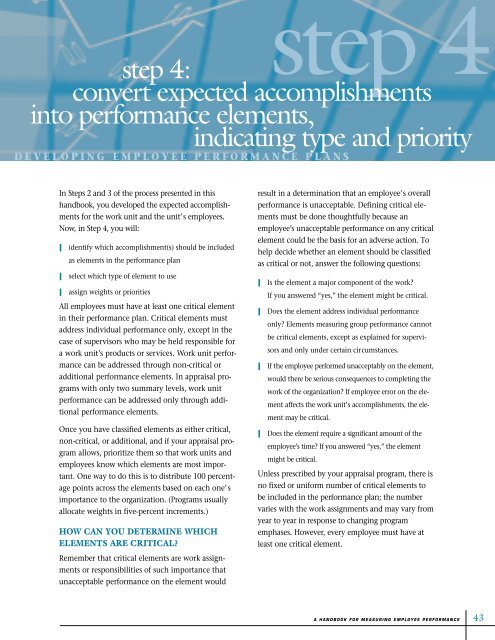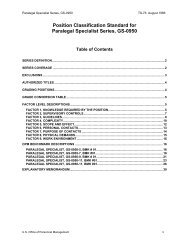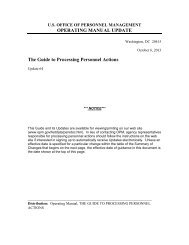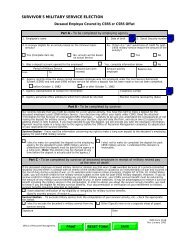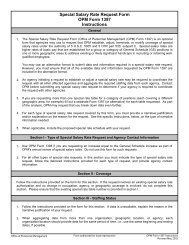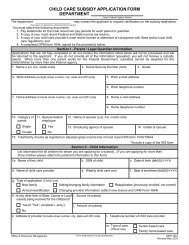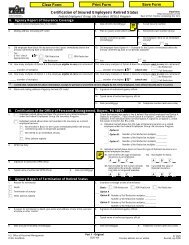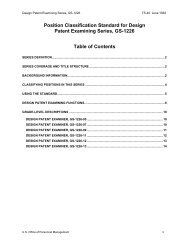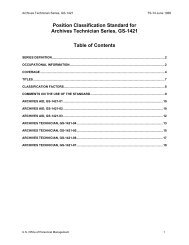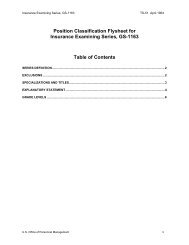A Handbook for Measuring Employee Performance - Office of ...
A Handbook for Measuring Employee Performance - Office of ...
A Handbook for Measuring Employee Performance - Office of ...
You also want an ePaper? Increase the reach of your titles
YUMPU automatically turns print PDFs into web optimized ePapers that Google loves.
step 4<br />
step 4:<br />
convert expected accomplishments<br />
into per<strong>for</strong>mance elements,<br />
indicating type and priority<br />
DEVELOPING EMPLOYEE PERFORMANCE PLANS<br />
In Steps 2 and 3 <strong>of</strong> the process presented in this<br />
handbook, you developed the expected accomplishments<br />
<strong>for</strong> the work unit and the unit’s employees.<br />
Now, in Step 4, you will:<br />
❙ identify which accomplishment(s) should be included<br />
as elements in the per<strong>for</strong>mance plan<br />
❙ select which type <strong>of</strong> element to use<br />
❙ assign weights or priorities<br />
All employees must have at least one critical element<br />
in their per<strong>for</strong>mance plan. Critical elements must<br />
address individual per<strong>for</strong>mance only, except in the<br />
case <strong>of</strong> supervisors who may be held responsible <strong>for</strong><br />
a work unit’s products or services. Work unit per<strong>for</strong>mance<br />
can be addressed through non-critical or<br />
additional per<strong>for</strong>mance elements. In appraisal programs<br />
with only two summary levels, work unit<br />
per<strong>for</strong>mance can be addressed only through additional<br />
per<strong>for</strong>mance elements.<br />
Once you have classified elements as either critical,<br />
non-critical, or additional, and if your appraisal program<br />
allows, prioritize them so that work units and<br />
employees know which elements are most important.<br />
One way to do this is to distribute 100 percentage<br />
points across the elements based on each one’ s<br />
importance to the organization. (Programs usually<br />
allocate weights in five-percent increments.)<br />
HOW CAN YOU DETERMINE WHICH<br />
ELEMENTS ARE CRITICAL?<br />
Remember that critical elements are work assignments<br />
or responsibilities <strong>of</strong> such importance that<br />
unacceptable per<strong>for</strong>mance on the element would<br />
result in a determination that an employee’s overall<br />
per<strong>for</strong>mance is unacceptable. Defining critical elements<br />
must be done thoughtfully because an<br />
employee’s unacceptable per<strong>for</strong>mance on any critical<br />
element could be the basis <strong>for</strong> an adverse action. To<br />
help decide whether an element should be classified<br />
as critical or not, answer the following questions:<br />
❙ Is the element a major component <strong>of</strong> the work?<br />
If you answered “yes,” the element might be critical.<br />
❙ Does the element address individual per<strong>for</strong>mance<br />
only? Elements measuring group per<strong>for</strong>mance cannot<br />
be critical elements, except as explained <strong>for</strong> supervisors<br />
and only under certain circumstances.<br />
❙ If the employee per<strong>for</strong>med unacceptably on the element,<br />
would there be serious consequences to completing the<br />
work <strong>of</strong> the organization? If employee error on the element<br />
affects the work unit’s accomplishments, the element<br />
may be critical.<br />
❙ Does the element require a significant amount <strong>of</strong> the<br />
employee’s time? If you answered “yes,” the element<br />
might be critical.<br />
Unless prescribed by your appraisal program, there is<br />
no fixed or uni<strong>for</strong>m number <strong>of</strong> critical elements to<br />
be included in the per<strong>for</strong>mance plan; the number<br />
varies with the work assignments and may vary from<br />
year to year in response to changing program<br />
emphases. However, every employee must have at<br />
least one critical element.<br />
A HANDBOOK FOR MEASURING EMPLOYEE PERFORMANCE 43


